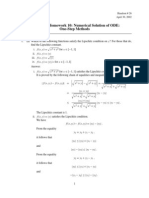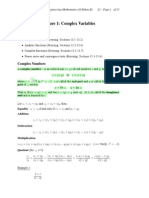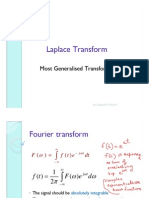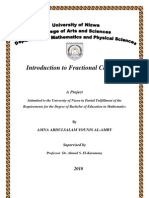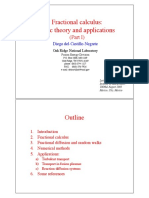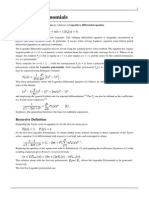Chapter 01 - Introduction To Vector Analysis
Uploaded by
Jan Ebenezer MorionesChapter 01 - Introduction To Vector Analysis
Uploaded by
Jan Ebenezer MorionesLECTURE 1
INTRODUCTION TO VECTOR ANALYSIS
1.01 SCALAR Any quantity specified by a single number or value. Examples of scalars are time, mass, distance, speed, energy, work, and potential difference. 1.02 VECTOR Any quantity specified by a magnitude and a direction. A vector can be represented by two or more scalars. Examples of vectors are displacement, velocity, force, momentum, and field intensity. 1.03 NOTATIONS USED IN THIS BOOK There are many accepted notations in writing scalars and vectors. Aside from the arrow written on top, each character representing a vector is written in Boldface type to add emphasis. This book will use the following notations: Scalars: k , K , m, M r Vectors: A, CD Unit vectors: a A , a CD , (a x , a y , a z ), (a , a , a z ), (a r , a , a )
1.04 WRITING SCALARS AND VECTORS BY LONGHAND By longhand it is easier to write vectors by Plain type (not Boldface type) characters. Scalars: k , K , m, M r Vectors: A, CD Unit vectors: a A , aCD , (a x , a y , a z ), (a , a , a z ), (ar , a , a )
1.05 RECTANGULAR COORDINATES Also called the Cartesian coordinate system, it is the most commonly use coordinate system to represent vectors in three-dimensions. Rectangular coordinate system defines a point or a vector using three mutually perpendicular number lines, namely the x axis, the y axis, and the z axis. It is base on the geometry of a parallelepiped wherein the origin is located on one corner and the axes are the edges of the parallelepiped.
Fig. 1.1 Point and unit vectors in rectangular coordinate system 1.06 VECTOR IN RECTANGULAR COORDINATES
Fig. 1.2 Vector in rectangular coordinate system as a sum of components In component form,
r A = Ax a x + Ay a y + Az a z
r where: Ax , Ay , Az = components of A in the x, y, z directions respectively a x , a y , a z = unit vectors in the x, y, z directions respectively
1.07 MAGNITUDE OF A VECTOR The length of a vector. The distance from the tip to the tail of the arrow representing the vector. It is also called the Euclidean norm.
r 2 A = A = Ax2 + Ay + Az2
Fig. 1.3 Magnitude of a vector
r Example 1.01 Find the magnitude of vectors A = 4a x + 5a y + 6a z and r B = 3a x + 4a y + 2a z .
Solution:
A = 4 2 + 5 2 + 6 2 = 8.775
B = (3) 2 + 4 2 + 2 2 = 5.385
r 1.08 UNIT VECTOR IN THE DIRECTION OF A r Vector of unit length pointing in the direction of A
r A aA = A r Fig. 1.4 Unit vector in the direction of A
Example 1.02 Find the unit vector in the direction of r r a) A = 4a x + 5a y + 6a z , and b) B = 3a x + 4a y + 2a z Solution: a)
r A 4a x + 5a y + 6a z aA = = A 8.775 a A = 0.456a x + 0.570a y + 0.689a z r B = 3a x + 4a y + 2a z aB = = B 5.385 a B = 0.557a x + 0.743a y + 0.371a z
b)
1.09 POSITION VECTOR Directed distance from the origin to point P( xP , yP , z P ) .
r r R P = R OP = xPa x + yPa y + z Pa z
Fig. 1.5 Position vector Example 1.03 Find the vector extending from a) the origin to point P(6,1,8) , b) the origin to point Q(2,9,4) . Solution: r r R P = R OP = 6a x + a y + 8a z r r R Q = R OQ = 2a x + 9a y 4a z
1.10 DISTANCE VECTOR Directed distance from the point P( xP , yP , z P ) to point Q( xQ , yQ , zQ ) .
Fig. 1.6 Distance vector
r R PQ = ( xQ xP )a x + ( yQ yP )a y + ( zQ z P )a z
In terms of position vectors,
r r r R PQ = R P R Q
Example 1.04 Find the vector extending from P(6,1,8) to Q(2,9,4) . Solution: r R PQ = (2 + 6)a x + (9 1)a y + (4 8)a z r R PQ = 8a x + 8a y 12a z
1.11 NULL VECTOR Also called zero vector, is a vector with zero length. Null vector has no specific direction and unit vector. In rectangular coordinate system, r 0 = (0)a x + (0)a y + (0)a z .
1.12 PROBLEMS: 1) Identify the following quantities as scalar or vectors. a. volume b. acceleration c. torque d. density e. angular velocity 2) Elevation is a scalar quantity, how do cartographers normally draw a map representing the different elevations on the surface of the Earth? Aside from geography, cite other examples utilizing the same technique. 3) The average radius of the Earth is 6,371 km. If the center of the Earth is at the origin, the z axis passes through the North Pole, and the
x axis passes through intersection of the Prime Meridian and the
Equator, find:
a. the position vector
at point A( x A , y A , z A ) , 100 m above the
surface of the Earth at the intersection of the Prime Meridian and the Equator (The point is above the Atlantic Ocean). b. the position vector at point B( x B , y B , z B ) , 5 km below the surface of the Earth at the South Pole. c. the distance vector from point B( x B , y B , z B ) to point A( x A , y A , z A ) . 1.13 PROBLEMS: 1) Determine the position vectors of each of the following points: a) A(1,4,5) , b) B(3,4,5) , c) C (2,2,0) , d) D(4,1,0) 2) Determine the length and unit vector in the direction of each of the position vectors in (1).
r r r r 3) Specify the distance vectors a) R AB , b) R CB , c) R CD , d) R DA .
4) Find the perimeter of the quadrilateral ABCD . 5) Specify the position vector of the midpoint of line BC . Find the perimeter of the triangle OMC . 1.14 SUPPLEMENTARY PROBLEMS: 1) Determine the length and unit vector in the direction of each of the r r r vectors a) J = 6a x + a y + 8a z b) K = 4a y + 2a z c) L = 3a x + 5a y . r r r r 2) Specify the position and distance vectors a) R P , b) R Q , c) R PQ , d) R QP if P(3,8,4) and Q(8,0,1) . 3) Find the length of each of the vector in (2). 4) What is the perimeter of the triangle OPQ ? 5) Determine the position vector at the midpoint M of the line PQ .
You might also like
- 13 Years Test Experience With Short Circuit Withstand Capability of Large Power TransformersNo ratings yet13 Years Test Experience With Short Circuit Withstand Capability of Large Power Transformers7 pages
- Lecture Notes On Mathematical Methods PH2130 - 2012/2013: Glen D. Cowan Physics DepartmentNo ratings yetLecture Notes On Mathematical Methods PH2130 - 2012/2013: Glen D. Cowan Physics Department8 pages
- Numerical Analysis by Dr. Anita Pal Assistant Professor Department of Mathematics National Institute of Technology Durgapur Durgapur-713209No ratings yetNumerical Analysis by Dr. Anita Pal Assistant Professor Department of Mathematics National Institute of Technology Durgapur Durgapur-71320915 pages
- 2 Integral Definition and Properties of Gamma and Beta FunctionsNo ratings yet2 Integral Definition and Properties of Gamma and Beta Functions8 pages
- المرشد-لحل-المعادلات-التفاضلية-العادية ـ موقع الفريد في الفيزياءNo ratings yetالمرشد-لحل-المعادلات-التفاضلية-العادية ـ موقع الفريد في الفيزياء203 pages
- Solution of Abel's Integral Equation by Using Soham TransformNo ratings yetSolution of Abel's Integral Equation by Using Soham Transform8 pages
- 4.6 - Gradient, Divergence, Curl, and Laplacian - Mathematics LibreTextsNo ratings yet4.6 - Gradient, Divergence, Curl, and Laplacian - Mathematics LibreTexts10 pages
- (GEM 601) Exercises For Special FunctionsNo ratings yet(GEM 601) Exercises For Special Functions2 pages
- Chapter 02 (Solution of Algebraic & Transcendental Equation)100% (1)Chapter 02 (Solution of Algebraic & Transcendental Equation)24 pages
- Solution of Algebric & Transcendental EquationsNo ratings yetSolution of Algebric & Transcendental Equations22 pages
- Sample For Solution Manual Elements of Electromagnetics 7th Edition by Matthew SadikuNo ratings yetSample For Solution Manual Elements of Electromagnetics 7th Edition by Matthew Sadiku14 pages
- Electromagnetic Fields by R.K.wangsness (2nd)No ratings yetElectromagnetic Fields by R.K.wangsness (2nd)599 pages
- Lesson 6. Non Homogenous Equation Undetermined CoefficientsNo ratings yetLesson 6. Non Homogenous Equation Undetermined Coefficients7 pages
- Positive Definite Matrices: Notes On Linear Algebra100% (1)Positive Definite Matrices: Notes On Linear Algebra51 pages
- Systems of Odes. Phase Plane. Qualitative Methods Qualitative MethodsNo ratings yetSystems of Odes. Phase Plane. Qualitative Methods Qualitative Methods26 pages
- Student Solutions Manual To Accompany Advanced Engineering Mathematics VOL 260% (5)Student Solutions Manual To Accompany Advanced Engineering Mathematics VOL 2222 pages
- Section 1.5 General Second Degree Equations PDF100% (1)Section 1.5 General Second Degree Equations PDF3 pages
- Introduction To Fractional Calculus Amna Al - Amri Project October 2010No ratings yetIntroduction To Fractional Calculus Amna Al - Amri Project October 201029 pages
- Fractional Calculus: Basic Theory and Applications: (Part I)No ratings yetFractional Calculus: Basic Theory and Applications: (Part I)23 pages
- Numerical Analysis - Sivarnamakrishna Das, C. Vijayakumari First, 2014 -Compressed100% (1)Numerical Analysis - Sivarnamakrishna Das, C. Vijayakumari First, 2014 -Compressed385 pages
- 093 - MA8353 Transforms and Partial Differential Equations - NotesNo ratings yet093 - MA8353 Transforms and Partial Differential Equations - Notes73 pages
- 1-Vector Analysis-Algebra and Basics of Vector SY 2020-2021 - ECENo ratings yet1-Vector Analysis-Algebra and Basics of Vector SY 2020-2021 - ECE46 pages
- Knowledge Check: Operational Amplifier: Aol AcmNo ratings yetKnowledge Check: Operational Amplifier: Aol Acm2 pages
- Di Mentioning A Simplex Swirl Injector JournalNo ratings yetDi Mentioning A Simplex Swirl Injector Journal15 pages
- Fm/Am Compact Disc Player: CDX-G1280UM/CDX-G1201U/CDX-G1200U/ CXS-G1269U/CXS-G124SU/CXS-G1216UNo ratings yetFm/Am Compact Disc Player: CDX-G1280UM/CDX-G1201U/CDX-G1200U/ CXS-G1269U/CXS-G124SU/CXS-G1216U56 pages
- Introductory Chapter: New Challenges and Innovations in Grape and Wine ProductionNo ratings yetIntroductory Chapter: New Challenges and Innovations in Grape and Wine Production8 pages
- Ipc847e Operating Instructions EnUS en-USNo ratings yetIpc847e Operating Instructions EnUS en-US212 pages
- MOEP - Public-Private Partnership Development in Thermal Power Generation, Thermal Power Department, Myanmar Electric Power EnterpriseNo ratings yetMOEP - Public-Private Partnership Development in Thermal Power Generation, Thermal Power Department, Myanmar Electric Power Enterprise15 pages
- Pediatrics PreTest Self Assessment and Review Twelfth Edition Robert Yetman - The ebook in PDF format is ready for immediate access100% (1)Pediatrics PreTest Self Assessment and Review Twelfth Edition Robert Yetman - The ebook in PDF format is ready for immediate access50 pages
- Comparison of The ASME, BS and CEN Fatigue Design Rules For Pressure Vessels (October 2003)No ratings yetComparison of The ASME, BS and CEN Fatigue Design Rules For Pressure Vessels (October 2003)2 pages
- 13 Years Test Experience With Short Circuit Withstand Capability of Large Power Transformers13 Years Test Experience With Short Circuit Withstand Capability of Large Power Transformers
- Lecture Notes On Mathematical Methods PH2130 - 2012/2013: Glen D. Cowan Physics DepartmentLecture Notes On Mathematical Methods PH2130 - 2012/2013: Glen D. Cowan Physics Department
- Numerical Analysis by Dr. Anita Pal Assistant Professor Department of Mathematics National Institute of Technology Durgapur Durgapur-713209Numerical Analysis by Dr. Anita Pal Assistant Professor Department of Mathematics National Institute of Technology Durgapur Durgapur-713209
- 2 Integral Definition and Properties of Gamma and Beta Functions2 Integral Definition and Properties of Gamma and Beta Functions
- المرشد-لحل-المعادلات-التفاضلية-العادية ـ موقع الفريد في الفيزياءالمرشد-لحل-المعادلات-التفاضلية-العادية ـ موقع الفريد في الفيزياء
- Solution of Abel's Integral Equation by Using Soham TransformSolution of Abel's Integral Equation by Using Soham Transform
- 4.6 - Gradient, Divergence, Curl, and Laplacian - Mathematics LibreTexts4.6 - Gradient, Divergence, Curl, and Laplacian - Mathematics LibreTexts
- Chapter 02 (Solution of Algebraic & Transcendental Equation)Chapter 02 (Solution of Algebraic & Transcendental Equation)
- Sample For Solution Manual Elements of Electromagnetics 7th Edition by Matthew SadikuSample For Solution Manual Elements of Electromagnetics 7th Edition by Matthew Sadiku
- Lesson 6. Non Homogenous Equation Undetermined CoefficientsLesson 6. Non Homogenous Equation Undetermined Coefficients
- Positive Definite Matrices: Notes On Linear AlgebraPositive Definite Matrices: Notes On Linear Algebra
- Systems of Odes. Phase Plane. Qualitative Methods Qualitative MethodsSystems of Odes. Phase Plane. Qualitative Methods Qualitative Methods
- Student Solutions Manual To Accompany Advanced Engineering Mathematics VOL 2Student Solutions Manual To Accompany Advanced Engineering Mathematics VOL 2
- Introduction To Fractional Calculus Amna Al - Amri Project October 2010Introduction To Fractional Calculus Amna Al - Amri Project October 2010
- Fractional Calculus: Basic Theory and Applications: (Part I)Fractional Calculus: Basic Theory and Applications: (Part I)
- Numerical Analysis - Sivarnamakrishna Das, C. Vijayakumari First, 2014 -CompressedNumerical Analysis - Sivarnamakrishna Das, C. Vijayakumari First, 2014 -Compressed
- 093 - MA8353 Transforms and Partial Differential Equations - Notes093 - MA8353 Transforms and Partial Differential Equations - Notes
- 1-Vector Analysis-Algebra and Basics of Vector SY 2020-2021 - ECE1-Vector Analysis-Algebra and Basics of Vector SY 2020-2021 - ECE
- Vector and Tensor Analysis with ApplicationsFrom EverandVector and Tensor Analysis with Applications
- Fm/Am Compact Disc Player: CDX-G1280UM/CDX-G1201U/CDX-G1200U/ CXS-G1269U/CXS-G124SU/CXS-G1216UFm/Am Compact Disc Player: CDX-G1280UM/CDX-G1201U/CDX-G1200U/ CXS-G1269U/CXS-G124SU/CXS-G1216U
- Introductory Chapter: New Challenges and Innovations in Grape and Wine ProductionIntroductory Chapter: New Challenges and Innovations in Grape and Wine Production
- MOEP - Public-Private Partnership Development in Thermal Power Generation, Thermal Power Department, Myanmar Electric Power EnterpriseMOEP - Public-Private Partnership Development in Thermal Power Generation, Thermal Power Department, Myanmar Electric Power Enterprise
- Pediatrics PreTest Self Assessment and Review Twelfth Edition Robert Yetman - The ebook in PDF format is ready for immediate accessPediatrics PreTest Self Assessment and Review Twelfth Edition Robert Yetman - The ebook in PDF format is ready for immediate access
- Comparison of The ASME, BS and CEN Fatigue Design Rules For Pressure Vessels (October 2003)Comparison of The ASME, BS and CEN Fatigue Design Rules For Pressure Vessels (October 2003)


